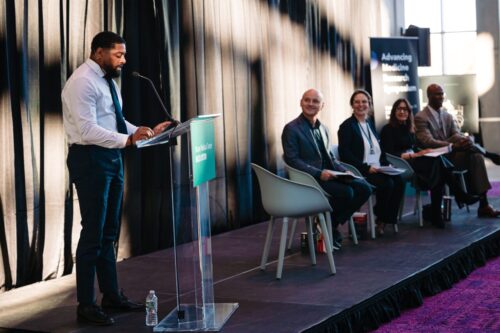StreetCred Has Advice for New Parents: Open a 529 Plan
December 7, 2021
By Wayne Zhong, By Swetha Tummala, By Lucy Marcil, MD

Getty Images
Boston Medical Center's tax-prep program explains the broader benefits of opening a college savings account and will help families do it.
For many cash-strapped families, opening investment accounts may not seem practical at first, let alone an effective way to close the racial wealth gap. But they should consider them, and a 529 college savings account is an easy, low-risk first step. To help uninitiated families learn what they are and why they should open one, StreetCred piloted embedding a service and literacy program around 529s.
StreetCred is a Boston Medical Center program co-founded by pediatrician Lucy Marcil, MD, MPH, that offers free tax and financial services to families to help create economic mobility.
Between 2009 and 2019, the price of college increased 133%, according to the National Center for Education Statistics. The average sticker price for tuition and fees at a typical four-year private nonprofit college reached $38,070 for the 2021-2022 school year, according to a report by the College Board—though most students paid closer to $15,000, thanks to grant aid.
What have parents done to prepare for this investment? For some, 529 plans are an increasingly popular way to save for college. A 529 plan is a tax-advantaged investment account used to save for qualified education expenses, where earnings grow tax-free over time.
Beyond accumulating savings, the 529 has broader advantages. Studies show that simply enrolling in a plan may influence child development.
In June 2021, the total assets of 529 plans hit a record high of $464 billion, with an average plan balance more than $30,287. The COVID-19 pandemic has also spurred an increase in college savings accounts (CSA) in general. By the end of 2020, CSAs in 36 states rose 30% from 2019, according to Prosperity Now, a nonprofit focused on expanding economic opportunity.
But the 15.3 million open 529 accounts belong disproportionately to families who are college-educated, higher income, and white. Families served by BMC, on the other hand, mostly live in disinvested communities, where 85% of patients are on Medicaid and 70% of children are children of color. Most parents that StreetCred spoke with had never heard of a 529 plan.
College savings coaching at the doctor’s office
Beyond accumulating savings, the 529 has broader advantages. Studies show that simply enrolling in a plan may influence child development. One study found that low-income 4-year-olds with a state-funded 529 account—which the state of Oklahoma automatically opened and seeded with $1,000 as an experiment in inclusive asset-building—scored higher on a social-emotional developmental screening than peers without accounts, regardless of parental saving behavior. Maternal depression rates were also found to be lower. Another study showed that low- and middle-income students with even $1 in their 529s are three times more likely to enroll in college and four times more likely to graduate than students without accounts.
Creating generational wealth begins with investing in our children.Click To Tweet
Capitalizing on the free $50 that Massachusetts offers families who open a state-managed account within one year of their child’s birth, StreetCred embedded 529 college savings account enrollment assistance and education in a trusted, frequented place: the pediatrician’s office. Birth registry staff who helped new parents complete birth certificate forms provided families with a flyer on 529s. A trained medical student followed up with families and helped them open accounts. Program materials were available in English, Spanish, Haitian Creole, and Portuguese.
StreedCred called 628 families of infants born at BMC in the first three months of 2020. Out of the 364 families reached, 177 wanted to learn more. Ultimately, 38 families opened a 529 account, and 85 families said they were considering it. Although our program of directed outreach showed a less-than-ideal success rate of 10%, this preliminary result is part of an effort to refine our approach. In 2021, we ran a revised pilot with 100 families in the Pediatric Practice of the Future, the clinic run by BMC’s Center for the Urban Child and Healthy Family, and found that making a financial coach available during visits, texting, and post-visit phone support led to 20% of families opening accounts.
A lack of time and financial literacy
In our outreach effort, we identified two key barriers to opening an account through our program: time and financial literacy. Parents of a newborn child lack dedicated time to talk on the phone to learn about investment accounts. Families frequently cited mealtime and childcare as reasons for declining to explore the service.
Financial literacy is a significant barrier as well. Many families we spoke with said they did not understand how investments worked or how to open an account. This is an even bigger barrier for families who speak Spanish, Haitian Creole, or other languages because financial websites generally are only available in English. They also had a fear of investing, which can be intimidating—especially when, lacking disposable cash, they’re asked to invest in an account that can only be used for a specific purpose and generally not for 18 years.
StreetCred focused on encouraging families to take advantage of the $50 incentive to gain useful financial knowledge rather than asking families to save money they may not have.
StreetCred focused on encouraging families to take advantage of the $50 incentive to gain useful financial knowledge rather than asking families to save money they may not have. The $50 was a major factor to encourage parents to at least open a 529 account. One mother we spoke with had never heard of Fidelity, the financial services company that manages the Massachusetts 529 plan. Our conversation helped build her trust in financial institutions and encouraged her to enroll in financial coaching, which can help open the door to financial independence and deeper conversations about money and wealth.
Investing in economic equity beyond college savings accounts
Embedding systematic education and support accessing financial services for low-income families of color could help build economic equity, which is directly linked to racial health equity. An increasing number of U.S. states and cities are recognizing the need and creating college savings accounts with automatic enrollment, including New York City, Maine, Pennsylvania, Nevada, and San Francisco. But most programs, including the one in Massachusetts, require opting in, thus providing an additional barrier to setup.
Typically, savings from 529 plans only cover a small portion of a child’s college costs. Among parents who contributed to a 529 or other college fund, those savings covered, on average, only 11% of the child’s cost of attendance in 2020, according to a Sallie Mae and Ipsos report. By the time a child turns 18, an average 529 account has around $3,000, hardly enough to cover the costs of books and housing at a four-year university, let alone tuition. For low-income families, savings are likely even less.
While 529s alone, without significant contributions from government or private sector, may not be the solution to achieving economic equity and accumulating generational wealth, they do serve a broader purpose of advancing child health and development. And they can be introduced, along with financial coaching, tax preparation, and other asset-building services, in health clinics nationwide as part of a larger financial support package offered to all pediatric families, especially lower-income families of color.
Our experiences over the past year have shown that more resources are needed to support those in need. Having dedicated time at a well-child visit and a larger funding contribution from the state would support parents more in their journey toward financial empowerment. Creating generational wealth begins with investing in our children.


